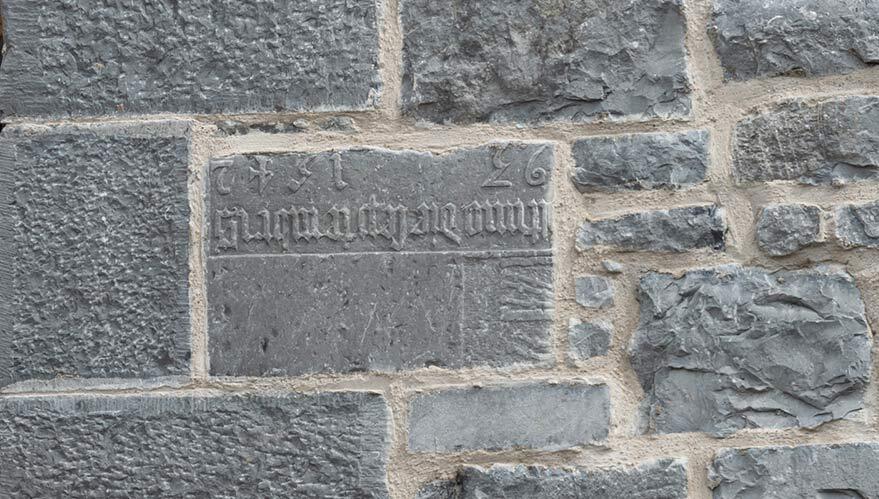The uses of the site on which Butler Gallery sits, and the buildings it has held, have evolved over the centuries to reflect the story and history of Kilkenny & Ireland and it remains one of Kilkenny’s most iconic and historic locations today.
The site is steeped in heritage. It evolved from a priory for augustinian priests who lived a monastic life in the 13th Century Catholic Ireland, to becoming a Military Barracks in the mid 17th Century during the Cromwellian invasion of Ireland, during which the monasteries were destroyed by the forces of the English parliament. Later the building was recommissioned as an Alms House in the early 19th Century by Joseph Evans’ for domestic servants who had fallen on hard times and evolved into a Nursing Home which it remained until the mid-1990’s.
Refurbishing Evans' Home presented a wonderful opportunity for Butler Gallery to join this legacy and retain the site as a public place in the city.
Priory to Gallery
 View Gallery
View Gallery
Priory
The parish of St. John stood on the North East edge of medieval Kilkenny, enclosed by its own stone walls and separated from the rest of the city by the river Nore.
The first use of the site of Butler Gallery, that we know of, was the Hospital of St. John in 1212. It was William Marshall, Earl of Pembroke who granted a charter to the Canons Regular of St. Augustine to build a new priory here in 1240.
The priory site included a covered mill race along the western side and a monastic cemetery on the east. The original priory was recorded as having a church, a belfry, a cemetery, various chambers and dormitories, a grain store, dining hall, kitchens, two orchards and three gardens. The Lady Chapel was built in 1290 and new building works began in 1325. The Belfry collapsed in 1329.
The Priory of St. John continued until 1540 and the dissolution of the monasteries under King Henry VIII during the Protestant Reformation. At this time a portion of the property was granted to Kilkenny City Corporation and the citizens of Kilkenny. By 1615 the nave and chancel of the church were in ruins, but the bakehouse, cart gate, ‘castle’, chapter house, cloisters, garden, and a great kitchen, were still in use. Subsequently most of the Priory of St. John fell into ruins.
Kilkenny was an important political and military site, known as the second city of Ireland. During the civil wars of the mid 17th century it was the capital of the Catholic Confederacy. In 1645, a college for 18 Jesuit priests was established in the surviving priory buildings. The college had an oratory, a library; refectory, dormitory, various parlours, kitchens, orchards, and an arboretum.
Military Barracks
In 1650 Oliver Cromwell captured the city of Kilkenny and the Jesuit college was converted to a military hospital. By the turn of the century, the first infantry barracks was constructed here using the stones of the priory and Jesuit college. Many of these medieval cut stones were further recycled in 1818 into the Evans’ Home. The most obvious example of this can be found today on the front corner of the west wing of Butler Gallery.
Evans’ Home
In 1817 the elegant Lady Chapel of the priory was re-roofed and converted into a church to serve the Church of Ireland parish of St. John, just one year before Evans’ Home was created under the Evans Trust. Most of the other priory buildings have long since disappeared, but some remains can still be seen at Michael Street. The nave of the church was dismantled in the 18th Century.
Originally known as the Evans' Asylum, the Evans' Home was built as an alms house for impoverished former domestic servants in 1818. Joseph Evans, a wealthy Kilkenny landowner, made over his entire fortune of £24,000 to set up the Evans’ Trust. Its purpose was to improve conditions for poor and homeless people in Kilkenny.
Joseph Evans’, willed his entire fortune and extensive properties to charitable purposes under the Evans’ Trust, including a school, support for orphans, apprenticeships and marriage dowries for the poor and the home for impoverished domestic servants.
More Info
Art Gallery
Evans’ Home remained in use as a home for domestic servants into the early 20th Century until the demand for domestic servants gradually declined. From then Evans’ Home became a Nursing Home, as it remained until the mid 1990’s when the last resident left. After this period the building fell into disuse for a number of decades until being given a new lease of life and being identified as the new home for Butler Gallery in 2010.
€6 million was raised from Kilkenny County Council, the Department of Heritage, Culture and the Gaeltacht and Fáilte Ireland to complete renovation and restoration of Evans’ Home with McCullough Mulvin Architects & Mythen Construction to make it a fit for purpose heritage building and art gallery.
For images of Evans' Home under construction being transformed to the present day Butler Gallery see Brian Cregan Photography Commission
Butler Gallery has four collection galleries highlighting our extensive and important Collection of 20th Century Irish art, a wing dedicated to renowned Kilkenny artists Tony O’Malley & Jane O’Malley, a large contemporary art gallery, a Learning Centre, a Digital Gallery and beautiful gardens which include a sculpture garden featuring Byzantine a work by artist Janet Mullarney, a wildflower garden and an archaeology garden.
In our intimate garden setting you can enjoy refreshments from our café, Wild Flower Café, with views of medieval St John’s Priory.



 Opening Hours
Opening Hours